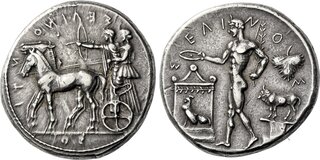| Numismatica Ars Classica > Auction 146 | Auction date: 8 May 2024 |
| Lot number: 2089 Price realized: This lot is for sale in an upcoming auction - Bid on this lot  | Show similar lots on CoinArchives Find similar lots in upcoming auctions on |
| Lot description: Selinus. Tetradrachm circa 450, AR 27 mm, 17.48 g. ΣΕΛΙΝΟ – Ν – ΤΙ – ΟΣ retrograde Slow quadriga l. in which stand Apollo and Artemis, shooting arrow and holding reins respectively. Rev. Σ – ΕΛΙ – Ν – Ο – Σ The river-god Selinus naked standing l., holding branch and pouring libation over garlanded altar, in front of which stands cock; in field r., statue of bull standing l. on platform set upon stepped block; above, Selinon leaf. Rizzo pl. XXXI, 9 and enlarged on pl. XXXII, 2 (this coin). SNG Lloyd 1221 (these dies). Kraay-Himer pl. 66, 186 (this obverse die). Gillet 101 (this coin). Schwabacher 3b (this coin). Very rare and probably the finest specimen known. Perfectly struck on superb metal and exceptionally well centred and complete. Wonderful old cabinet tone and good extremely fine Ex Leu-M&M 1974, Kunstfreund, 101; Leu 76, 1999, 49; NAC 48, 2008, 39 and NGSA IX, 2015, Thyssen-Kaplan, 14 sales. From the Star collection. The close relationship between the Classical period coinage of Selinus and Himera has not escaped notice, as it seems to provide evidence of ties between these two cities, despite their locations on opposite shores of Sicily. We can recognise a general similarity between the tetradrachms of these cities: both have a chariot scene on the obverse and a sacrifice scene on the reverse. We can also see that a cock, the badge of Himera, has been incorporated into the design of this magnificent Selinus tetradrachm; indeed, it enjoys as prominent a position as the Selinon leaf, which was the canting type for Selinus. The solidarity of these Greek cities dates back to at least 480 B.C., when Himera and Selinus alone supported the Carthaginians against Acragas, who was a troublesome rival to both. It is a curious, yet typically Greek Sicilian twist of fate that Himera and Selinus were both destroyed by Carthage in 409 B.C. The chariot scene is atypical in that it includes two deities – in this case the sibling gods Apollo and Artemis. Artemis drives the quadriga as her twin brother Apollo draws his bow; the choice of this type is hardly surprising since Apollo was the deity of choice at Selinus, which had a massive temple dedicated to the god on its eastern hill. The reverse shows the river-god Selinus holding a lustral branch of purification as he strides toward a garlanded altar to sacrifice from a patera (for four interesting varieties, see Kraay-Hirmer nos. 186, 188-190). We are fortunate that the inscription names Selinus, who otherwise might be mistaken for Apollo. In addition to the aforementioned cock and Selinon leaf, there is also a bull upon a monumental base. Were it not for the fact that the base differs so greatly from one die to the next, we might presume that it was a local monument; but the inconsistent presentation virtually rules out that possibility. A. H. Lloyd, in his study of the coin types of Selinus in the 1935 Numismatic Chronicle, identifies the statue as the brazen bull of Phalaris in which Phalaris of Acragas (tyrant c. 570-549 B.C.) is said to have roasted his enemies alive. Since Himera was one of the important acquisitions of Phalaris in his quest to become tyrant of Sicily, Lloyd considered this type to represent the longstanding friendship between Himera and Selinus. Estimate: 75000 CHF |  |



